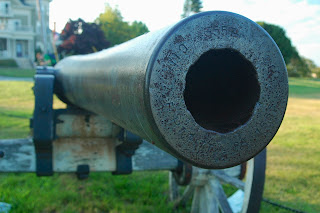After several hours of recovery and a goodly long nap I'm back to almost human.
Dinner was gazpacho and a huge pickle from a giant jar purchased while returning from my last adventure at the Botanical Gardens, a kidnapping from the back of Bradbury Mountain, a story I've not quite figured out how to tell yet.
Today was very much different.
I love driving through the Crawford Notch State Park up Route 302 in New Hampshire. I take it straight Northwest to hook up with US 93 and thence to visit the Ferguses and their horses in Vermont.
The drama of the landscape never fails to energize and enthrall me, compelling me to stop and make a futile attempt to capture it by camera.
With the unusual luxury of two consecutive days off - Monday and Tuesday - I decided last night to drive up and hike somewhere in the park - anywhere.
A quick look at the park website led me to the Arethusa Falls - and the Frankenstein cliff.
How can you refuse a location named after a non-ravished nymph and a monster created by Mary Shelly?
 Listening to David Sanipass the other night (Native American 2.0, if you're interested in reviewing) had send me up Bradbury Mountain a few days later - but somehow this seemed more important.
Listening to David Sanipass the other night (Native American 2.0, if you're interested in reviewing) had send me up Bradbury Mountain a few days later - but somehow this seemed more important.David's discussion of the universality of experience - though he sees it in spiritual terms and I in emotional/psychological terms - had brought a lot of thoughts and feelings to the surface of my life.
I experience everything as connected. We all have an effect on each other - like the famous "Butterfly Effect", where the flapping of a Beijing butterfly can cause a Florida hurricane. It hit me during a conversation with the friend whom I'd run into at David's talk that if I allowed my imagination to fully take hold of my conscious vision I could literally see the lines of connection from everything to everything, like lines of yarn spun from light, a dazzling web of influence and connection.
And I think this vision was what was driving me up the mountain today. I had to go someplace with a solid physical presence, a grounded place, literally, that I could then feel myself traveling over, traveling through.
So there I was, making my way up the trail.
My GPS track from MapMyWalk is posted above. The walk forward and back was only 3.3 miles, slightly longer than Bradbury.
The climb? Much, much more demanding.
 The trail, rated "medium" is very rocky, with the path worn between large rocks covered with thick roots, either of which can toss you over and down a very steep drop to the stream below.
The trail, rated "medium" is very rocky, with the path worn between large rocks covered with thick roots, either of which can toss you over and down a very steep drop to the stream below.It's a challenge - there is a point where the sense of "how much further up can I go" begins to obsess you. Looking to the left after 40 minutes shows another mountain peak, clear in the sky directly across from you.
The reality of how far you've come can begin to balance the concern with how far you have to go.
Just like the falls in Portland you heard Arethusa well before you see it. The trail gives up some of its height (and you think "wait, I'll have to climb back up before I can climb back down?") They are very dramatic, a ribbon of water than makes a formidable ice fall for climbing in Winter.
Today a surprising number of people had made the trip. The bottom of the falls seemed full of people, at least five groups - only one of which spoke English (I did have a brief chat with some Germans visiting from Hamburg - they knew about Curry Queen, a Facebook page for a local fast food shop in the Erikastrasse - that was odd).
There were stones piled at the bottom, scattered like giant's playthings, cracked off the stone face of the mountain through ice and erosion. They gave you no real place to sit, your legs had to brace to hold you up on the tumbled rocks - not really a rest to prepare for the climb down.
A frugal snack of water, an apple and my constant friends - salted almonds - brought out local companionship - a red chipmunk kept flirting with my backpack, running up to it and then dashing away.
Strategic tossing of my hard-portaged apple brought my new acquaintance nearby for some impromptu portraiture - we sat and looked at each other for a few quick moments.
I wondered what it thought of me, what it saw. I assume it was accustomed to being around people, it was a popular spot and half those around me were snacking - some on trail mix, some on Pringles - and the chipmunk might make a good living in the Summer.
In the Winter, the ice climbing season - well, it was a popular ice-climb as well, so maybe it wouldn't be so bad.
With that I had to leave. I suppose burning my body out to climb a trail to consider a chipmunk was not a total waste of an afternoon.
Portland, Maine










